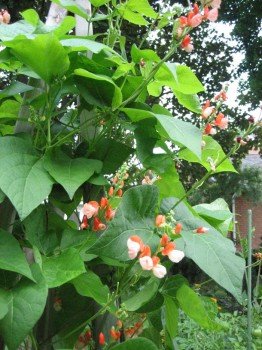
Is this early hot weather useful for anything? Yes, the soil has warmed and it’s just the right temperature to provide a rousing start for warmth-loving vegetables like pole beans, seeded directly into garden soil. If some bizarre turn of events forced me to select only one vegetable to grow, it would be pole beans. These are the tender-fleshed green, yellow and purple snap beans sold in markets as string beans (although they are mostly string less).
This might seem a peculiar interest coming from a gardener who makes a lot of fuss over roses, but pole beans are the most rewarding plant I can think of, providing flowers, entertainment and food all in one small garden patch. I have even grown yellow ‘Soleil’ and green ‘Blue Lake’ pole beans in a container, set out on a city fire escape, and watched them quickly leap up to neighbours on upper levels. (Negotiations were necessary to prevent windows opening for unauthorized harvesting.)
If you’ve grown old-fashioned scarlet runner beans (Phaseolus coccineus) or ‘Painted Lady’ beans (P. c. ‘Painted Lady’) on a trellis or arbour — often planted for their flowers alone while their edible pods are ignored — you may understand the pleasure of watching these plants. All plants grow by utilizing carbohydrate energy resources, but the process is more rapid and visible in beans. I must make a distinction here, and point out that I find no pleasure in growing bush-form bean plants. They may produce the same beans, but it’s certainly not an entertaining process.
Once germinated and with a set of true leaves, pole beans begin to extend their stems, the important runners that carry foliage, flowers and pods along their length (wherever sunlight is sufficient). The stems have a clearly visible serpentine growth pattern. If left to sprawl on the ground (the worst thing that can happen to a pole bean), they will grow in a circular pattern, rising up cobra-like and desperately seeking vertical support. (This would be painful for me to watch.) Pole bean stems want to wrap around any vertical form, and will grow up heavy strings, wires, poles, tree trunks or even corn stalks.
Once given appropriate support, it’s a marvel to see how quickly the growing tip turns around a bamboo cane or heavy wire, twisting and gaining height hourly. If you measure and compare growth in the morning and at day’s end, you can appreciate their rapid rise. Then come the white, pink, purple or bi-colour flowers, soon followed by the dangling pods that gain length every day. And finally, you get to eat them!
Pole beans have broad leaves with delicate tissues easily damaged in windy locations where grit and sharp sand might be swirling about. (If your neighbour is excavating a building site, wait until next year to plant beans.) They want all the sun they can get, and evenly moist, well-draining soil. Drought seriously stunts their growth, and it’s wise to provide irrigation daily in hot weather, when the plants are forming pods.
Beans of all kinds are legumes, able to take gaseous nitrogen from the air, and fix it in nodules on their roots (feeding themselves and neighbouring plants). Nitrogen fixation and the bean harvest are greatly enhanced (possibly increased by more than 50 percent) when a rhizobia bacterial inoculant is applied to the seeds at planting time. Moisten the seeds and put them into a paper bag with the rhizobia powder; shake the bag to coat the seeds and plant immediately while still moist (the microorganisms will die if allowed to dry).
Legume inoculant can be purchased through seed catalogues and sometimes at garden centres. Be sure to purchase the correct rhizobia for your plant — snap beans (both pole and bush varieties), peas and lima beans require a different inoculant from the rhizobia used for clover, cowpeas, soybeans, and scarlet runner and ‘Painted Lady’ beans.








